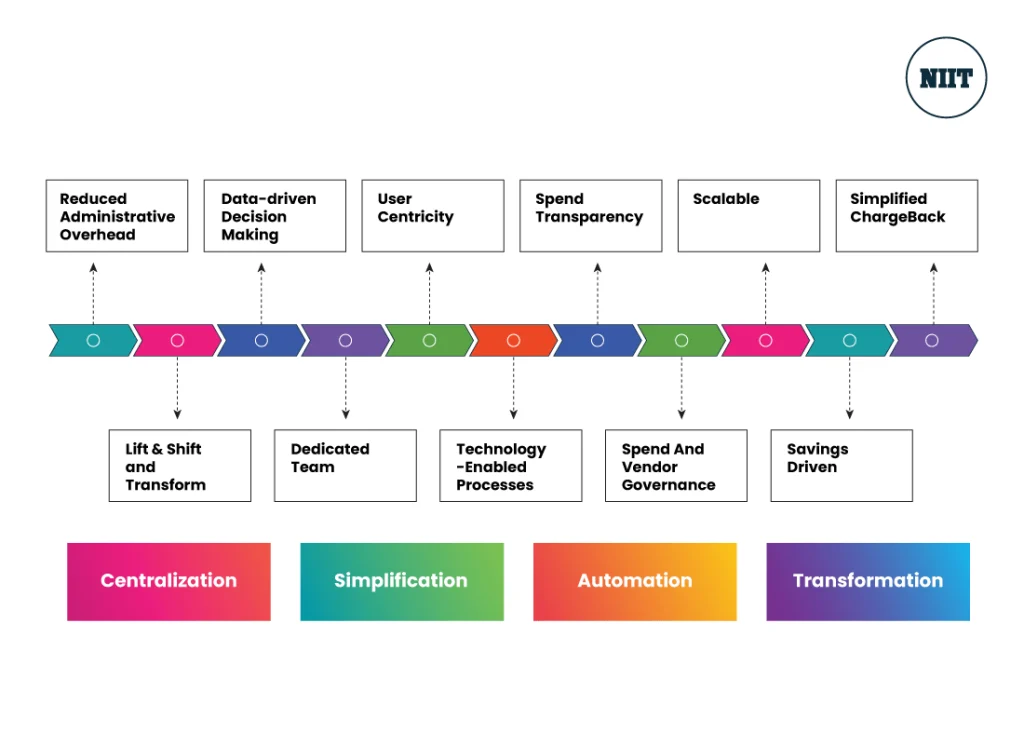
What is Strategic Sourcing? Turning L&D Vendor Management from Chaos to Clarity
The average enterprise L&D team today juggles a complex web of training providers, content partners, facilitation firms, and platform vendors. And they all operate in silos with different formats, price points, and priorities. What was meant to drive flexibility often devolves into chaos.
As learning demand grows across compliance, upskilling, and digital transformation, so does the strain on vendor management. Without a centralized strategy, organizations end up with:
- Dozens of scattered contracts
- Overlapping offerings
- Inconsistent learner experiences
- Limited visibility into total spend
The result? Wasted effort, rising costs, and diminished learning impact.
So, how do high-performing organizations move from fragmented vendor relationships to a streamlined, value-driven model?
It starts with a shift in mindset and a clear answer to one question: What is strategic sourcing?
What Is Strategic Sourcing in L&D?
At its core, strategic sourcing is a structured, insight-led approach to selecting, managing, and optimizing external vendors with the explicit goal of advancing your learning and development strategy.
It’s not about chasing the lowest price. It’s about designing a vendor ecosystem that delivers the greatest business value.
So, what is strategic sourcing comprised of? This robust strategy for growth includes several key steps:
- Analyzing enterprise-wide training spend
- Identifying redundancies and gaps
- Evaluating vendors based on alignment with capability goals
- Streamlining procurement processes
- Tracking performance against strategic metrics
In contrast to transactional buying, strategic sourcing management brings clarity, control, and scalability to the L&D supply chain.

What Happens When Vendor Management Is Decentralized?
Without centralized vendor management or clear strategic sourcing management, organizations often struggle to execute a cohesive learning and development strategy. The lack of consistent vendor management training leads to inefficiencies, hidden costs, and fragmented learner experiences. Here’s how decentralization creates barriers to effective L&D:
Lack of Spend Visibility
With each vendor delivering the learning data in its proprietary format, collecting, analyzing, and leveraging this information across the enterprise is extremely challenging. As a result, L&D leaders often struggle to assess which programs or partners are truly effective. Furthermore, the lack of centralized control hampers the ability to analyze the training investments across departments or business units. Without standardized data and enterprise-wide visibility, organizations struggle to measure ROI, align learning outcomes with business goals, or make informed, strategic decisions.
Administrative Overhead
Managing several vendors also means juggling multiple service-level agreements, contracts, invoice cycles, points of contact, and onboarding processes. For L&D teams, this translates into hours spent on procurement coordination rather than strategic learning design. In fact, studies show that internal L&D teams spend 30-40 percent of their time on administrative tasks rather than training activities. This slows down program rollout, drives up costs, and drains internal capacity.
Inconsistent Learner Experience
When the same training need is fulfilled through multiple vendors across the organization, it results in inconsistent content quality, delivery methods, and learning outcomes. Employees may receive training on the same topic from different providers, leading to variability in messaging, skill development, and engagement. This fragmented approach not only drives up costs but also undermines a cohesive learning experience across teams.
Misalignment with L&D Strategy
When vendor selection is driven by convenience or cost rather than strategic alignment, it weakens the overall impact of the learning function. Many organizations partner with vendors that may offer quality training but fail to address the specific skills, capabilities, or business outcomes the company is targeting. As a result, learning initiatives do not support long-term talent goals or measurable ROI.
Strategic Sourcing: An Effective Approach to Centralized Vendor Management
According to research, 40 percent of organizations currently utilize five or more content providers, with 14 percent managing ten or more. As organizations grapple with fragmented vendor ecosystems and rising learning demands, strategic sourcing emerges as a powerful solution to bring structure, control, and efficiency to L&D vendor management.
Here’s how strategic sourcing management is delivering meaningful value to organizations:
Vendor Consolidation and Cost Efficiency
One of the most immediate and visible benefits of strategic sourcing management is vendor consolidation. Many organizations work with multiple training providers across business units, geographies, and learning categories, resulting in redundant offerings, inconsistent pricing, and duplication of efforts in contracting and vendor onboarding.
Strategic sourcing allows organizations to reduce supplier fragmentation by consolidating similar services under fewer, high-performing vendors. This improves pricing leverage and reduces redundant or overlapping costs. Deloitte notes that having a centralized vendor management process, including preferred vendors and negotiated rates, can reduce costs.
Improved Quality and Consistency
A strategically sourced supplier base is not just smaller; it’s smarter and more scalable. Rather than relying on disconnected local vendors, strategic sourcing provides a global supplier network that allows learning leaders to support regional and global rollouts with consistency, leverage the same vendor across locations for economies of scale, and ensure compliance with global learning standards, legal requirements, and DEI goals.
Increased Efficiency and Agility
Traditional vendor onboarding and procurement processes are often slow and complex, misaligned with the fast-moving needs of modern L&D. Strategic sourcing streamlines these processes with predefined contracts, agile procurement models, and preferred vendor lists. This enables learning teams to launch programs faster and adapt quickly to emerging skill needs.
Visibility and Control
Without centralized oversight, learning spend often gets buried across departments, making it difficult to track true investment or align it with business outcomes. Strategic sourcing introduces clear visibility into training spend, enabling accurate forecasting and budget planning, spend analysis by vendor, geography, business unit, or modality, and identification of cost-saving opportunities. Through centralized contracts, data dashboards, and vendor reporting standards, learning leaders gain a real-time, data-driven view of their investments.
Stronger Strategic Alignment
Perhaps most importantly, strategic sourcing ensures vendor choices directly support your learning and development strategy. Vendors are evaluated not just on cost, but on how well their offerings address key skill gaps and support enterprise-wide goals such as digital transformation, leadership development, or DEI initiatives. In fact, Deloitte reports that 63 percent of high-performing organizations now structure their learning procurement around specific skill development needs rather than generic training courses. In other words, the training content and format are chosen to advance the company’s talent strategy.

Image: NIIT's end-to-end vendor management capabilities to save multi-million dollars for our customers.
Real-World Impact: A Strategic Sourcing Snapshot
Across industries, forward-looking organizations are already seeing measurable benefits. Take the example of one of the world’s leading oil and gas companies that operates in more than 70 countries. The company was grappling with a long tail of local and global third-party vendors, resulting in duplicate learning portfolios and unnecessary costs. The company, in partnership with NIIT, implemented a strategic sourcing and vendor management process. The outcome was significant, with the company streamlining operations and optimizing learning portfolios, achieving 12-18 percent savings across all learning portfolios, and reducing 23 percent in the total number of vendors.
What to Look for in a Strategic Sourcing Partner?
Successfully implementing strategic sourcing requires expertise, structure, and scale. The right partner can bring:
- Deep L&D domain knowledge
- Proven vendor management frameworks
- Global supplier networks
- Technology and tools to support real-time tracking
- Cross-functional alignment with procurement, HR, and business units
Chaos to Clarity Starts Here in Vendor Management
Managing a complex vendor ecosystem doesn’t have to mean complexity, cost, or confusion. With strategic sourcing, L&D teams can take back control and drive measurable improvements in cost, quality, speed, and alignment.
If your team is stuck in vendor chaos, it may be time to ask: What is strategic sourcing, and are we doing it right?
At NIIT, we help organizations bring order, purpose, and performance to their L&D supply chain with strategic sourcing models built for today’s learning landscape.
Explore how Strategic Sourcing and Vendor Management from NIIT can help your team go from chaos to clarity.